I'm creating an iOS app using swift. I want to build a non scrollable tableView which shows on screen all informations contained in datasource, so the height of each cell depends on the number of entries in data. For example, if the height of the view is 500 and data.count = 10, each cell's height is 50. A problem appears when the cell's height is ~100.8 (corresponding to 5 entries in my data, using my iPhone 5). In fact, even by setting tableView.separatorStyle = .None , a weird separator appears for this cell's height.
Below, the first image (7 entries in data) is normal and on the second (5 entries in data) those separators appear.
Here is my view controller :
import UIKit
class ViewController: UIViewController, UITableViewDelegate, UITableViewDataSource {
@IBOutlet weak var tableView: UITableView!
let reuseIdentifier = "Cell"
var data = ["bobby", "bob", "john", "helena", "clara", "oliver", "steve"]
var visibleHeight:CGFloat!
override func viewDidLoad() {
super.viewDidLoad()
edgesForExtendedLayout = .None
tableView.registerClass(UITableViewCell.self, forCellReuseIdentifier: reuseIdentifier)
editModeOff()
tableView.scrollEnabled = false
visibleHeight = viewVisibleSize.height
tableView.separatorStyle = .None
}
func tableView(tableView: UITableView, numberOfRowsInSection section: Int) -> Int{
return data.count
}
func tableView(tableView: UITableView, cellForRowAtIndexPath indexPath: NSIndexPath) -> UITableViewCell{
let cell = tableView.dequeueReusableCellWithIdentifier(reuseIdentifier, forIndexPath: indexPath)
cell.textLabel!.text = data[indexPath.row]
cell.selectionStyle = .None
return cell
}
func tableView(tableView: UITableView, moveRowAtIndexPath sourceIndexPath: NSIndexPath, toIndexPath destinationIndexPath: NSIndexPath) {
let stringToMove = data[sourceIndexPath.row]
data.removeAtIndex(sourceIndexPath.row)
data.insert(stringToMove, atIndex: destinationIndexPath.row)
}
func tableView(tableView: UITableView, commitEditingStyle editingStyle: UITableViewCellEditingStyle, forRowAtIndexPath indexPath: NSIndexPath) {
if editingStyle == .Delete{
data.removeAtIndex(indexPath.row)
tableView.deleteRowsAtIndexPaths([indexPath], withRowAnimation: UITableViewRowAnimation.Fade)
}
}
func tableView(tableView: UITableView, heightForRowAtIndexPath indexPath: NSIndexPath) -> CGFloat {
print(visibleHeight/CGFloat(data.count))
return visibleHeight/CGFloat(data.count)
}
func editModeOn(){
tableView.setEditing(true, animated: true)
navigationItem.rightBarButtonItem = UIBarButtonItem(barButtonSystemItem: .Done, target: self, action: "editModeOff")
}
func editModeOff(){
tableView.setEditing(false, animated: true)
navigationItem.rightBarButtonItem = UIBarButtonItem(barButtonSystemItem: .Edit, target: self, action: "editModeOn")
}
}
extension ViewController{
var viewVisibleSize:CGSize{
var size = view.bounds.size
if !UIApplication.sharedApplication().statusBarHidden{
size.height -= UIApplication.sharedApplication().statusBarFrame.height
}
if let navigationController = navigationController{
size.height -= navigationController.navigationBar.bounds.height
}
if let tabBarController = tabBarController{
size.height -= tabBarController.tabBar.bounds.height
}
return size
}
}

